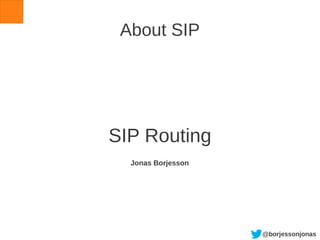
SIP Routing Demystified: Understanding How SIP Requests Traverse Networks
- 1. @borjessonjonas About SIP SIP Routing Jonas Borjesson
- 2. @borjessonjonas NOTE ● This presentation has been recorded and can be viewed here: vimeo.com/140267478 ● This version has been adapted to be viewed without transitions. ● Go to aboutsip.com to download the original version. ● Follow @borjessonjonas to receive updates.
- 3. @borjessonjonas Routing ● Understanding SIP routing is a must! ● SIP's flexible routing is what makes SIP so great*. ● The routing capabilities of SIP enables: ● Loosely coupled systems ● Ability for a very flexible application composition model ● NAT/FW Traversal ● CONFUSION! *According to myself. Many people may disagree...
- 4. @borjessonjonas Questions ● How does a SIP request traverse the network? ● How do we know which transport protocol to use? ● How do the responses find their way back? ● Any difference for in-dialog requests?
- 5. @borjessonjonas What do we need? ● In order to send a request we need to know: ● The IP-address of the destination (or the next hop) ● The port to send it to. ● Which transport to use (udp, tcp, tls or sctp?) ● So, how do we do this?
- 6. @borjessonjonas Locating SIP Servers ● RFC 3263 has all the answers. ● Makes use of DNS ● NAPTR lookup to find transport ● SRV lookup to find the port ● A-record lookup to find the IP-address
- 7. @borjessonjonas Find the transport ● If transport is specified, use it sip:alice@aboutsip.com;transport=udp ● If target is numeric IP, use UDP sip:alice@192.168.0.100 ● If no transport and target is not numeric but port is specified, use UDP* sip:alice@aboutsip.com:5090 ● If none of the above, do a NAPTR lookup on target IN NAPTR 10 10 "S" "SIPS+D2T" "" _sips._tcp.aboutsip.com IN NAPTR 20 10 "S" "SIP+D2T" "" _sip._tcp.aboutsip.com IN NAPTR 30 10 "S" "SIP+D2U" "" _sip._udp.aboutsip.com Locating SIP Servers * but you may use another transport if necessary (e.g. msg > MTU)
- 8. @borjessonjonas Find the port ● If port specified, use it. sip:alice@aboutsip.com:5070 ● If target is a numeric IP address and no port specified, use default for the selected transport. sip:alice@192.168.0.100;transport=udp => 5060 sip:alice@192.168.0.100;transport=tcp => 5060 sip:alice@192.168.0.100;transport=tls => 5061 ● Otherwise, perform a SRV query Locating SIP Servers _sip._udp.aboutsip.com 1800 IN SRV 10 10 5060 lb1.aboutsip.com _sip._udp.aboutsip.com 1800 IN SRV 10 10 5060 lb2.aboutsip.com
- 9. @borjessonjonas Find the IP Address ● If numeric IP address, use it. sip:alice@192.168.0.100 ● If SRV record lookup was performed, perform A record lookup based on that result. lb1.aboutsip.com ● Otherwise, do a A record lookup based on the domain in the SIP URI. sip:alice@aboutsip.com ● If many IP's are returned, try them top down. Locating SIP Servers lb1.aboutsip.com. 1800 IN A 10.36.10.10 lb1.aboutsip.com. 1800 IN A 10.36.10.11
- 11. @borjessonjonas For Requests ● If no Route-headers: use Request URI ● If Route-headers: use the top most Route-header ● BUT ● Is “lr” parameter present or not? ● Strict routing vs loose routing ● RFC 2543 vs RFC 3261
- 12. @borjessonjonas Hello Bob To: <sip:bob@aboutsip.com> From: <sip:alice@sipflow.io>;tag=oiu3rlkj CallId: asik3afj3knoiu2lkj CSeq: 1 INVITE MaxForwards: outbound.sipflow.io aboutsip.com Route: <sip:outbound.sipflow.io;lr> 70 Contact: <192.168.0.100;transport=tcp> Via: SIP/2.0/TCP 192.168.0.100;branch=z9hG4bKkljhasdf Via: SIP/2.0/TCP 62.4.10.10;branch=z9hG4bK32BDjdfd INVITE sip:bob@aboutsip.com SIP/2.0 sip:bob@10.36.10.11;transport=udp Via: SIP/2.0/UDP 82.67.45.50;branch=z9hG4bKdk3imiuj3
- 15. @borjessonjonas Subsequent Requests ● During the dialog initiation, a route-set is built (may be empty). ● The route-set is part of the dialog-state and must be preserved. ● Future in-dialog requests will follow that established route. ● The actual request itself is no different from a out-of-dialog request. It will follow the route-headers + request-uri... ●
- 16. @borjessonjonas Establishing the Route Set INVITE sip:bob@aboutsip.com SIP/2.0 To: <sip:bob@aboutsip.com> From: <sip:alice@sipflow.io>;tag=oiu3rlkj CallId: asik3afj3knoiu2lkj CSeq: 1 INVITE MaxForwards: outbound.sipflow.io aboutsip.com Route: <sip:outbound.sipflow.io;lr> Contact: <192.168.0.100;transport=tcp> RecordRoute: <sip:62.4.10.10;transport=tcp;lr> RecordRoute: <sip:82.67.45.50;transport=tcp;lr> Subsequent Requests
- 17. @borjessonjonas Establishing the Route Set SIP/2.0 200 OK To: <sip:bob@aboutsip.com>;tag=klajsdf From: <sip:alice@sipflow.io>;tag=oiu3rlkj CallId: asik3afj3knoiu2lkj CSeq: 1 INVITE Contact: <sip:10.36.10.11;transport=udp> Via: ... RecordRoute: <sip:82.67.45.50;transport=tcp;lr> RecordRoute: <sip:62.4.10.10;transport=tcp;lr> outbound.sipflow.io aboutsip.com Subsequent Requests
- 18. @borjessonjonas Dialog State Remote Target: sip:10.36.10.11;transport=udp Route Set: sip:62.4.10.10;transport=tcp;lr sip:82.67.45.50;transport=tcp;lr Subsequent Requests Remote Target: sip:192.168.0.100;transport=tcp Route Set: sip:82.67.45.50;transport=tcp;lr sip:62.4.10.10;transport=tcp;lr Note: There is more information stored in the dialog state. This example only highlights the routing information.
- 19. @borjessonjonas Constructing a Subsequent Request ● Remote target → Request URI ● Route set → Route Headers ● Send like any other request Subsequent Requests Remote Target: Route Set: sip:10.36.10.11;transport=udp sip:62.4.10.10;transport=tcp;lr sip:82.67.45.50;transport=tcp;lr BYE SIP/2.0 ... Route: Route: sip:10.36.10.11;transport=udp sip:62.4.10.10;transport=tcp;lr sip:82.67.45.50;transport=tcp;lr
- 21. @borjessonjonas Check this out INVITE sip:bob@aboutsip.com SIP/2.0 To: <sip:bob@aboutsip.com> From: <sip:alice@sipflow.io>;tag=oiu3rlkj CallId: asik3afj3knoiu2lkj CSeq: 1 INVITE MaxForwards: outbound.sipflow.io aboutsip.com Route: <sip:outbound.sipflow.io;lr> Contact: <192.168.0.100;transport=tcp> RecordRoute: <sip:62.4.10.10;transport=tcp;lr> Subsequent Requests Not Record-Routing!
- 22. @borjessonjonas Dialog State Remote Target: sip:10.36.10.11;transport=udp Route Set: sip:62.4.10.10;transport=tcp;lr sip:82.67.45.50;transport=tcp;lr Subsequent Requests Remote Target: sip:192.168.0.100;transport=tcp Route Set: sip:82.67.45.50;transport=tcp;lr sip:62.4.10.10;transport=tcp;lr Note: There is more information stored in the dialog state. This example only highlights the routing information.
- 25. @borjessonjonas Summary ● RFC 3263 is important! Read it! ● RFC 3261 explains which the “next uri” is: ● Requests – follows Route-headers plus Request-URI ● Responses – follows Via-headers ● Watch out for the old strict routing. ● Subsequent requests are really no different. ● Make sure you understand remote-target + route set as stored in the Dialog State.
- 26. @borjessonjonas More presentations and material at aboutsip.com Thanks!
